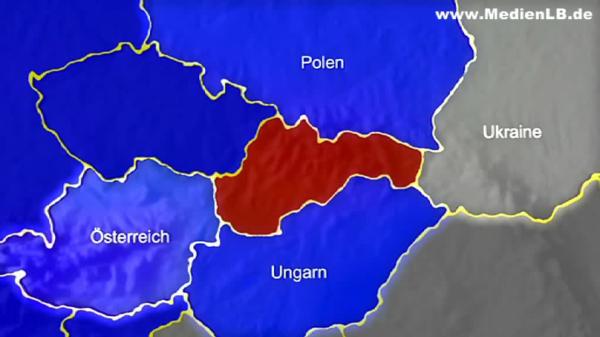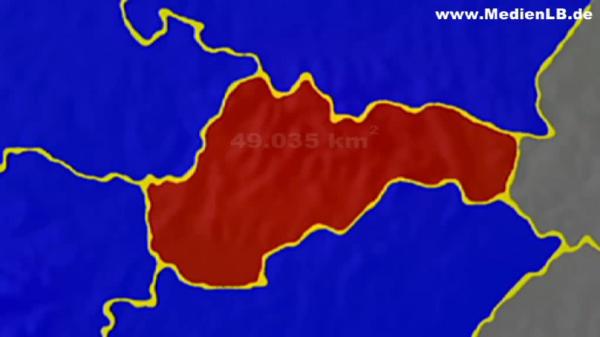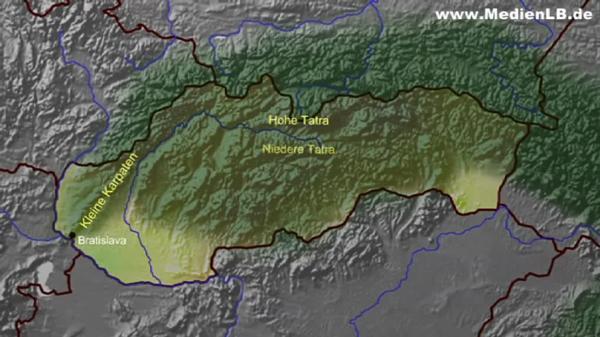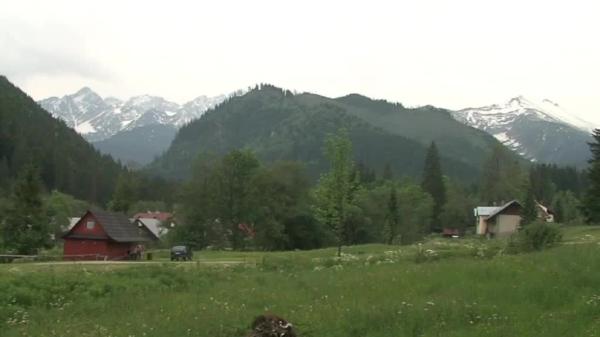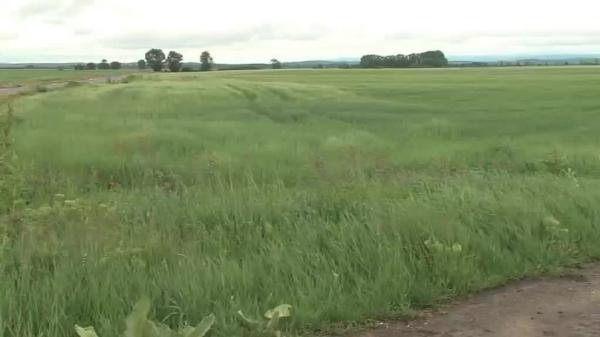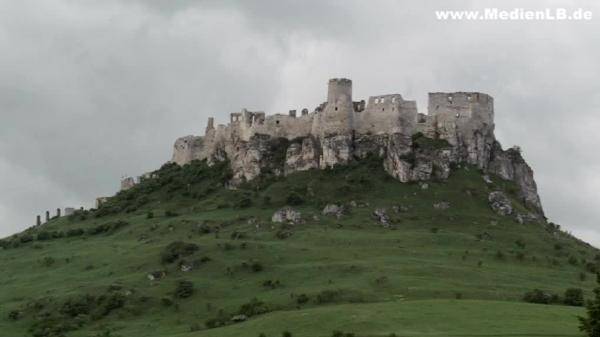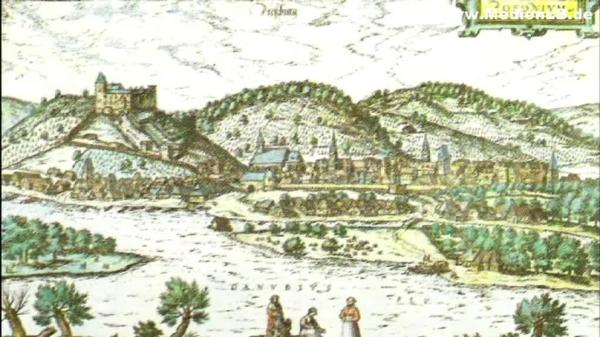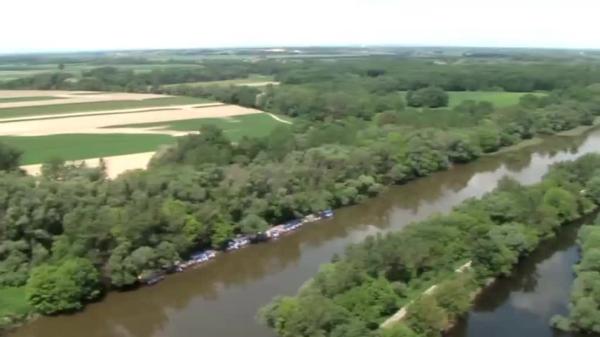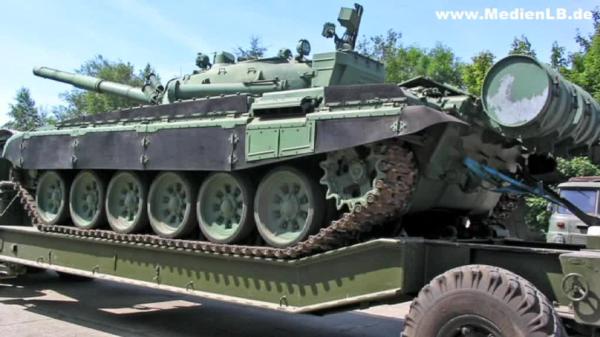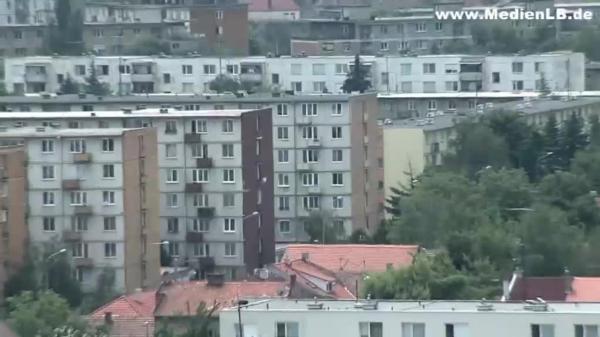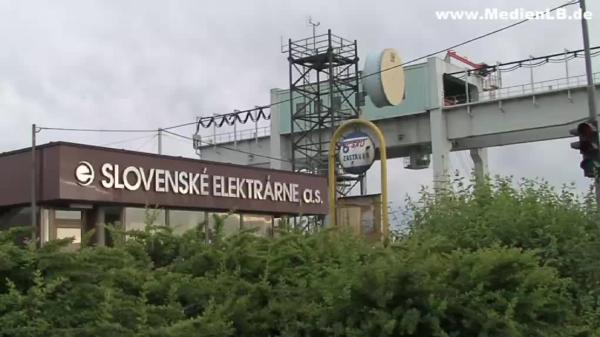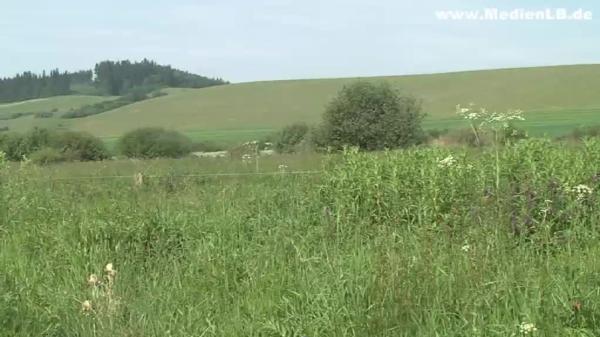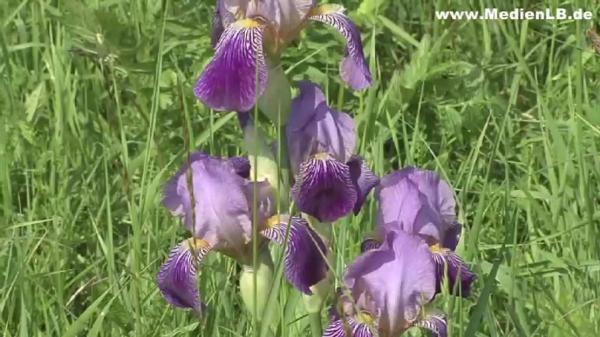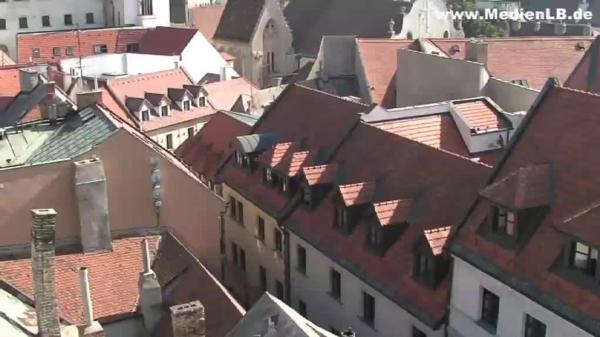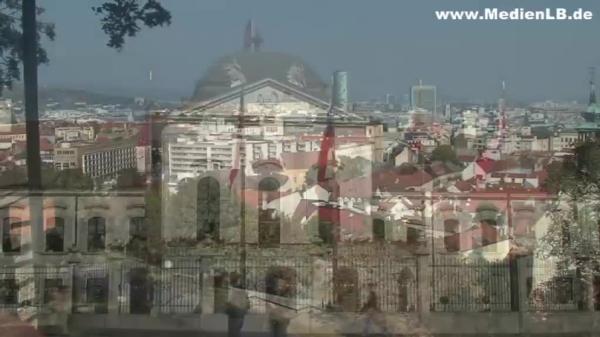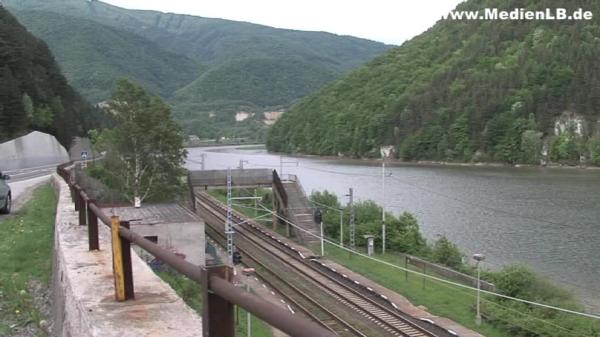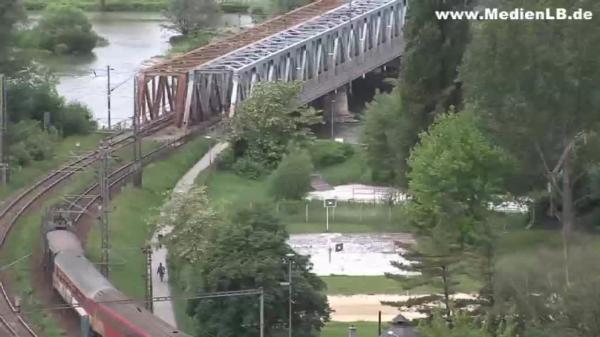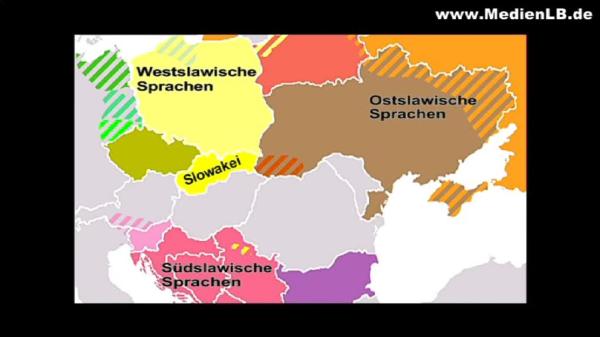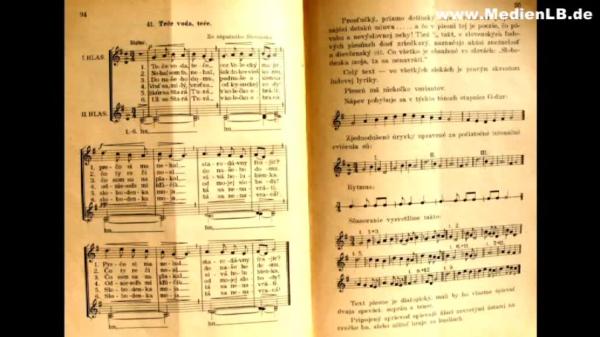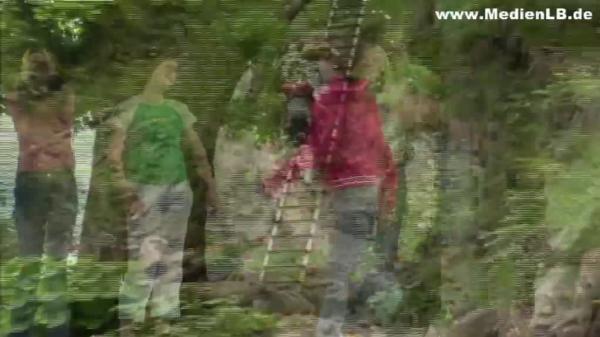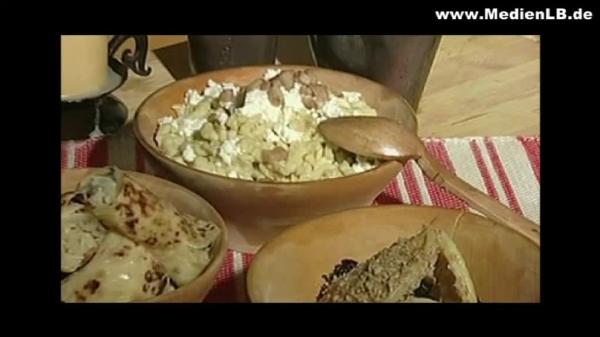Slowakei
Staaten der EU

Slovakia

!. Topography 1.1 Situation in Europe The Slovak Republic is situated in eastern Central Europe – in Slovakian Slovenskà republika or in short Slovensko – Slovakia. To the north Slovakia borders with Poland and to the east with the Ukraine. To the south there is the frontier to Hungary. The neighbours to the west are Austria and the Czech Republic. With an area of 49,035 square kilometres Slovakia is about one seventh of Germany and its more than 5.4 million inhabitants are about one fifteenth of the German population. Apart from more than 85 % of Slovaks the population of Slovakia consists of about 10 % of Hungarians and 2 % of Roma. Other minorities are Czechs, Ruthenians, Ukrainians and Germans. With an average age of 35.5 years, the population of Slovakia is among the very young nations of the European states. Since May 1st 2004 Slovakia is a member of the European Union. 1.2 Natural Landscape and Climate From the Danubian plains in the south to the mountains of the High Tatras in the north Slovakia has got a great number of varied and fantastic landscapes. In the north the ranges of the Carpathian Mountains characterize the landscape. They don't form one single range, but are subdivided into several low and high mountain ranges such as the Little Carpathian Mountains, the High Tatras, opposite them the Low Tatras and the Beskids. The ranges of the Little Fatras and the Greater Fatras as well as the Slovak Ore mountains – which cover the larger part of the centre of the country – belong to the Carpathian Mountains, too. In the southwest Slovakia covers part of the Hungarian Plain. The Eastslovak lowlands extend over the southeast of the country. The Slovakian climate is continental with dry hot summers and humid cold winters. The coldest month is January, July and August are the hottest. Higher locations are covered in snow for more than 120 days of the year. 1.3 Mountain Ranges The Carpathian Mountains cover the largest part of the country. They form a more than 1300 kilometre long and 100 to 350 kilometre wide arc, open to the west, which starts at Bratislava as a continuation of the Alps and ends in Rumania at the Iron Gate. Similar to the Alps the Carpathian Mountains are subdivided into different parts. The Outer Carpathians extend over the border area between the Czech Republic and Slovakia on the one hand and the border area between Slovakia and Poland on the other. The Inner Carpathians, directly adjoining to the south, encompass the highest mountains of the range. Part of the Tatras are the High Tatras in Slovakian 'Vysoké Tatry'. They are the highest part of the Carpathian Mountains and belong to two thirds to Slovakia, to one third to Poland. In both countries they are especially protected as a national park and belong to the biosphere reservation of the UNESCO. The Gerlachovský stít – in German Gerlsdorfer Spitze – is with its 2,655 metres the highest peak of the High Tatras, all the Carpathian Mountains and Slovakia. Because of their extent – not at all because of their height – the High Tatras are often called the smallest high mountain region on earth. The mountains offer an abundance of natural beauty such as the Strbské pleso – the Tschirmer Lake, a glacier lake. On 19th November 2004 a hurricane destroyed almost half of all trees on the Slovakian side of the High Tatras. The path of devastation is 3 kilometres in width and 50 kilometres in length. To the south extend the massive Slovak Ore Mountains. They are the most extensive mountain range of Slovakia. Its relief is massive and mostly arranged in plateaus. The once rich ore deposits such as iron, manganese, copper, lead, tin and antimony have always been mined, more intensively since the 14th century. Today, however, they are mostly exhausted. The Fatra is a name given to two ranges in the northwest and the centre of Slovakia: the Greater Fatras and the Little Fatras. They belong to the Slovakian part of the Carpathian Mountains. Both ranges are national parks. Even bears still live there. In the east of Slovakia the Forest Carpathians – a northern part of the Carpathian Mountains – begin, which continue into the Ukraine and Rumania. The name of the mountains points to the partly unspoiled unexploited forests of the region. In this area original customs can still be found. 1.4. Lowland Plains and Rivers In the southeast the Little Hungarian Plain extends across the Danube to the north until the foothills of the Slovakian Carpathian Mountains and their wide riverside areas. It is a flat, fertile landscape. Geotectonically the Little Hungarian Plain marks an interruption between the Eastern Alps and the Carpathian arc. The Eastslovak Lowland Plain, Východoslovenská nizina, is part of the Great Hungarian Lowland Plain. It extends over the southeast of the country and on its lowest stretches is situated about 90 to 100 metres above sea level. This plain is mainly drained by the tributaries of the Hungarian Tisza and the Slovakian Bodrog. Immediately after the Austrian-Slovakian border, the Dunaj – the Danube – passes the Slovakian capital of Bratislava. At the beginning the Dunaj shortly forms the border to Austria, then flows through the Slovakian capital and finally it forms the border to Hungary. The Waag – in Slovakian Váh – is the longest river of Slovakia with its 403 kilometres. It originates near the centre at the confluence of the White Váh and the Black Váh. In its further course it flows through the big Great Liptau reservoir, switches from wide plains to narrow canyons, flows round the high Slovakian mountain ranges in a huge half-circle and flows into the Danube at Komarno. In its lower reaches the Morava is the border river between the Czech Republic and Slovakia, respectively between Austria and Slovakia. It flows into the Danube below Devin castle near Bratislava. Slovakia has got several reservoirs. The best known is the Liptau reservoir. 45 square kilometres of Slovakia are covered by water. 2. History 2.1 The Slovaks under the Hungarian Crown For long periods of the 20th century the history of Slovakia is also a history of Czechoslovakia. About 500 b. Ch. the Slavonic ancestors of today's Slovaks arrived. At the beginning of the 9th century the Great Moravian Empire, a Slav principality was established on the territory of the Slovaks today. In the 11th century the area was incorporated in the Hungarian kingdom. What is Bratislava today became the capital and coronation site in 15 36 and kept this position until 1848. For more than 1000 years the Slovaks now shared the history of the Hungarian kingdom, which remained part of the Austro-Hungarian monarchy until the 1st World War. 2.2 Union and Division of Czechoslovakia After the disintegration of the Austro-Hungarian realm the Slovaks and the Czechs formed the independent Czechoslovakian Republic in 1918. After the 2nd World War the political union of Czechs and Slovaks was re-established and for more than 40 years the country belonged to the Eastern bloc. The river Morava became the insurmountable border to the West. It wasn't until 1989 that in the so-called 'velvet revolution' the non-violent change of system from communism to democracy succeeded. Also the division of the Czechoslovakian Republic on 1st January 1993 went off peacefully. Eventually a Czech and a Slovak Republic were founded. On 29th March 2004 the country became a NATO member state and on 1st May 2004 Slovakia joined the European Union along with the Czech Republic and 8 other countries. 3. Economy 3.1 Industry and Agriculture During Communist rule the markedly agrarian Slovakia was transformed into a centre of heavy industry. In the fields of steel production, chemical industry and armament industry Slovakia had a leading role among the states of the Warsaw Pact. Slovakia was considered the arms plant of the Warsaw Pact. The social upheaval at the beginning of the 90s entailed the restructuring and shutting down of whole branches of industry. Towards the end of the 90s, however, an economic boom was triggered and today the country is a popular production site. The share of agriculture in the gross domestic product amounts to 3 or 4 % today. About 6 % of the workforce work in agriculture. The most important agrarian products are wheat, potatoes, sugar beets, soybeans, fruit, pigs, cattle, poultry and timber. But also hop, for beer has a long tradition in Slovakia. The Slovakian industry employs about 30 % of the working population and is on the upswing. Leading branches of industry are - mechanical engineering and automobile industry, - chemical and pharmaceutical industry , - energy generation and - metal production. Especially due to the specific tax rate 'flat tax' for the cheap workforce, but also due to its central location in Europe, more and more companies from abroad move to Slovakia. The most significant trading partner and investor for Slovakia with a share of more than one third is Germany. In the Volkswagen car factory at Bratislava near the Austrian border about 6.500 employees manufacture besides the models Golf and Bora also gears and their component parts. Moreover, the VW-Touareg is built completely in the Slovakian VW plant in Bratislava. In Trnava PSA Peugeot Citroen opened a new plant in 2006. The steel mill of US Steel near the town of Kosice in Eastslovakia is with more than 16.000 employees the most important employer of this region and the biggest producer of rolled steel in Central Europe. The factory of the Slovakian aluminium giant AluTiRex is among the best of the world because of its quality. Within a radius of 1.000 kilometres this is the most important electrolytical factory. In Komárno on the Danube the Slovenské Lodenicé shipyard even builds ships suitable for the high seas. 3.2 Energy and Mining Slovakia has got 6 power stations. They provide most of the electricity needed. Two of these stations are nuclear power plants: Mochovce and Jaslovské Bohunice. Reactors one and two of the nuclear power station of Bohunice are to be switched off by 2008. The spaciously laid out power station of Gabcikovo is a hydroelectric power station and uses the water power of the Danube. It is the largest power station of Slovakia and generates about 11 % of the electric current required nationally. A huge oil refinery is located in the capital Bratislava. The most important mineral resources are lignite coal, small amounts of iron, copper and manganese ore and salt. 4. Tourism 4.1 Popular Holiday Destinations The alpine landscape of the Tatras is the main Slovakian tourist attraction. Around the communities of Poprad and Strbské Pleso there are excellently developed areas for wintersports and hiking with possibilities for climbing and skiing. Another popular holiday activity in Slovakia besides hiking is hunting, as there are still almost untouched stretches of natural landscape. The medieval Spis castle (Spisský hrad) in Eastslovakia has counted among the world cultural heritage of the UNESCO since 1993. It perches on a 634-metre-high rocky limestone peak and is the biggest castle in Central Europe. Numerous health resorts attract visitors. The spa resort of Piest'any – situated on the Váh in the west of Slovakia – counts among the most popular and most frequented spas of Slovakia with its natural thermal springs and its high-standard medical care. In the east of Slovakia there are still very picturesque wooden churches. 4.2 Cities worth seeing Slovakia has also quite a lot to offer to the culturally interested visitor. Its location close to the borders of several countries and its many ethnic minorities render the two bigger cities of Bratislava and Kosice especially interesting. The once Austro-Hungarian cities both have wonderfully preserved old town centres. Kosice, in German Kaschau, is situated in Eastslovakia, has 234.969 inhabitants and thus is the second largest city of the country. The St.Elizabeth cathedral, or Kaschauer Dom, is in the centre of Kosice and is the largest church of Slovakia. Kosice is a university town and also has besides the national theatre – the Státne Divadlo – the first professionally run Roma theatre. With almost 91,000 inhabitants Presov is the third biggest town of Slovakia. The town has a historically significant old town centre. An important monument is the St. Nicholas church, a late Gothic hall church. Apart from Bratislava Nitra is probably the oldest Slovakian town. It has 86.000 inhabitants and is above all a cultural and educational centre. The castle of Nitra with its nested churches, its bishop's seat and the surrounding fortifications counts among the most interesting building complexes of Slovakia. Banská Bystrika is located close to the geographic centre of the country, on the river Hron. The town has about 82,000 inhabitants and is considered historically a famous mining town of both the middle ages and the modern age. The beautifully laid out main square is well worth seeing. Trencin is an important centre in the middle of the Váh valley in Westslovakia near the border to the Czech Republic. The town has about 57.000 inhabitants. On a steep rock the castle of Trencin rises above the town. From here you have a magnificent view over the town and the Váh valley. 4.3 The Capital Bratislava On the Danube, where three countries meet, directly at the national borders to Austria and Hungary, not far from the border of the Czech Republic and only about 60 kilometres away from Vienna there is the Slovakian capital Bratislava, in German Pressburg. With its 425,000 inhabitants Bratislava is the biggest city of the country and also the political, economic and cultural centre of Slovakia. Bratislava is situated on the Danube, which is up to 300 metres wide here and spanned by several bridges. The best known and most modern of them is the Nový Most, the New Bridge, a huge road and footway bridge leading from the southern bank of the Danube towards the old town centre, which is one of the landmarks of the city. On a rock on the left bank of the Danube rises another landmark of the city – the castle of Bratislava. The imposing building with its four towers can also be found on the Bratislava coat of arms. Upstream, next to the castle there is the modern building of the Slovak parliament. Bratislava has a picturesque old town centre, which is characterized especially by the late baroque architectural style of the Theresian Era. The Slovak national theatre and the Slovak Philharmonic orchestra underline the city's cultural significance. In the church of St. Martin, the St. Martin's cathedral, the Hungarian kings were crowned from 1563 to 1830. A gilt crown at the top of the 85-metre-high steeple still reminds us of it. Maria Theresa, too, was crowned Queen of Hungary here in 1740. Other important sights are: - The main square with the old town hall and the Maximilian- or Rolandfountain, the oldest fountain in town, - the Grassalkovich Palace, the present seat of the Slovakian president and - the Michael's Gate in the Michael's Lane. The large district of Petrzalka has an especially high population density. The great number of blocks of flats of prefabricated slabs, however, doesn't offer a very varied sight. 5. Infrastructure, Population and Cultural Life 5.1 Traffic Network The traffic network is concentrated on Bratislava in the west and on Kosice in the east. With the country being very mountainous, it is oriented towards the valleys and rivers. The most important train connections are the electric railway from east to west, from the Ukraine via Kosice to Bratislava, continuing towards the Czech Republic, Vienna and Hungary. The motorway network is being extended. Its main connections follow the railway lines. Apart from that there is a fully developed transit road network. Bratislava is an international road and railway junction point. The biggest Slovakian airport, Letisko Bratislava, has its catchment area in Austria, Slovakia, the Czech Republic and Hungary. The second important airport of the country is the Letisko Kosice. Since June 2006 the fast catamaran Twin City Liner has connected the two capitals Vienna and Bratislava via the Danube three times a day. The journey Bratislava – Vienna lasts about 75 minutes. 5.2 Religion and Language About 70 % of Slovaks belong to the Roman-Catholic church. Around 13 % don't belong to any denomination – the others are Protestant, Greek-Catholic or members of the orthodox-church or of the Jewish faith. The Slovak language – just like among others the Czech and the Polish languages belongs to the Westslavonic languages. The Slovak and the Czech are different above all because of special sounds. The vocabulary is largely identical apart from the differences in sound. In the Slovak pronunciation – just as in Czech – in principle the first syllable is stressed. Therefore the Slovaks and the Czechs understand each other fairly easily, though younger people, who haven't grown up in the former Czechoslovakia, have clearly greater problems. Since 1st May 2004 the Slovak language is one of the official languages in the EU. 5.3 Cultural Heritage The central position of the country right in the middle of the continent has always been a meeting point of many different cultures, where Slovakia not only absorbed foreign influences but also passed on its own values. Museums and galleries manage and cultivate this rich and varied heritage. National and regional customs are preserved especially in the country. They are linked to the different religions, above all to the Roman-Catholic faith. In the first half of the 19th century the Slovak writer and politician L'udov´t Stúr caused the Central Slovak dialect to be accepted as the standard language thus creating today's version of the Slovak literary language. The founder of Pop-art, Andy Warhol, is Slovakian by birth. His parents immigrated from the village of Miková vear Medzilaborce – in the Carpathian Mountains – to the USA. His original name was Andrej Warhola. 5.4 Leisure-time Activities Its entry into the European Union brings the country closer to the other nations, entailing quite new possibilities of looking beyond national boundaries. Due to the many mountains especially climbing and hiking are very popular for leisure and sports - also with the young Slovaks. 5.5 Culinary Delights Throughout the centuries the Slovakian way of cooking has strongly been influenced by its neighbours. It's similar to Bohemian and Hungarian cooking. A typical national dish are the Bryndzové halusky – Brimsennocken. They are small potato dumplings with ham and the famous Bryndza, a cheese made of sheep's milk. Bryndzové halusky are the pride of the people. Another national dish is Pirohy, stuffed pasta squares in sour cream. Stuffed pancakes and soup are eaten daily and can be varied and given any possible flavour. And another favourite: KLÁRKA - a walnut cake which is very popular especially in the east of Slovakia. After the Iron Curtain had disappeared and the separation from the Czech Republic, Slovakia has succeeded brilliantly in re-establishing itself an autonomous state - which it had also been in former times. With its numerous national parks, its picturesque hills and high mountains, its marvellously beautiful thriving towns, its tradition and its open-minded, friendly people Slovakia occupies an important place in the east of the European Union.


